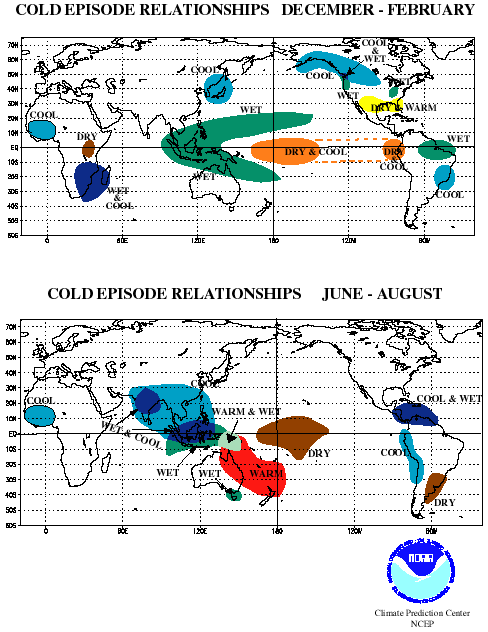Global impacts of La Niña
|
B. Geerts and E. Linacre |
3/’02 |
La Niña is the counterpart of an El Niño, with below-normal SST anomalies off Peru, and in the central equatorial Pacific. Because the Pacific-wide SST is lower, a La Niña event is also known as the cold phase of the ENSO. Some people refer to it as El Viejo (the old man), in order to avoid sexist terminology. During a La Niña, the Walker circulation is stronger and deep convection is suppressed in the central equatorial Pacific (Fig 1).

Fig 1. SST, thermocline, and zonal equatorial wind circulation during a La Niña.
La Niñas are usually weaker, less defined and less consistent than El Niño events. Therefore, some consider it as the 'normal state' rather than the opposite end of the pendulum; however a few La Niñas have been strong, with SST anomalies up to 4K (compared to 5-6K for the '97-'98 and the '82-'83 El Niños). A strong El Niño is not always followed by a strong La Niña. However a strong La Niña has always been followed, within a year, by an El Niño, at least during the 20th century. The seasonal modulation of La Niña events is weaker than that of La Niños which tend to peak around year's end.
One estimate is that El Niño events exist for 31% of the time, and La Niñas for 23%. Moderate to strong La Niñas this century began in 1903, 1906, 1909, 1916, 1924, 1928, 1938, 1950, 1954, 1964, 1970, 1973, 1975, 1988, 1995, 1998. The mean period is 6 years, ranging between 3-13 years.
The global climate impact of La Niñas is less understood and probably weaker than that of El Niños. During a La Niña both the Australian and the Asian monsoon tend to be stronger, and the wintertime jet stream is more zonal over North America, making the Pacific Northwest wetter than normal and the Southeastern US drier and warmer (Fig 2). Most anomalies are the reverse of those associated with El Niños.

Fig 2. Global La Niña climate impacts (cold episode) during the northern hemisphere winter (top) and summer (bottom).
Reference
(1) La Niña Workshop, 98 (held on 15-17 July 1998 in Boulder, Colorado, USA).